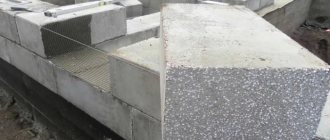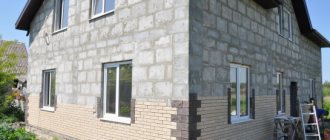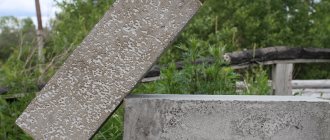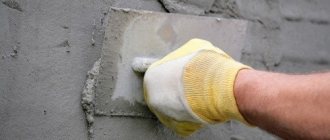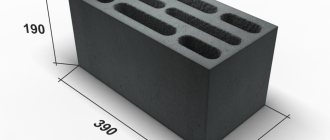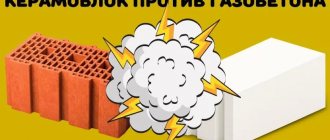If you ask a random person to list the popular materials for building a house, most likely the first options will be wood and brick. This has been the case for many centuries, but in the last fifty years a lot has changed. Thanks to the development of construction technologies, building materials with new properties have appeared; one of them was called polystyrene concrete.
Initially, the material was not widespread (due to the high cost of raw materials). In the late 60s, it was possible to improve the technological process and reduce costs. From this moment on, polystyrene concrete blocks (PSB blocks) have become a popular material, especially in demand in suburban low-rise construction. Today, the largest consumers of this inexpensive and practical building material are Germany, France, the USA and Canada.
Ready-made polystyrene concrete blocks Source krsk.au.ru
Polystyrene concrete: getting to know the material
Polystyrene concrete is a composite (complex in composition) material belonging to the class of lightweight concrete. Lightweight concrete has a reduced density, which allows solving several construction problems:
- reduce the weight of the building;
- increase its thermal insulation characteristics;
- reduce the cost of construction (by reducing labor costs and increasing the productivity of builders).
For the production of polystyrene concrete the following is used:
- Portland cement (a type of cement);
- water;
- polystyrene, filler in the form of granules of various fractions with heat-insulating properties (polystyrene is a polymer with a wide range of uses);
- quartz sand;
- plasticizers - various additives (for example, resin) that improve the plasticity of the mixture; Thanks to this, the blocks do not crack during hardening and drying.
Polymer granules (very similar to foam balls) create the lightweight structure of polystyrene concrete. The low density of foam and aerated concrete is ensured by air pores resulting from a chemical reaction.
Polystyrene granules Source archidea.com.ua
Manufacturing
To make polystyrene concrete yourself, you will need to use the following tools and materials:
- Concrete mixer.
- Shovel
- Water.
- Cement mixture.
- Quartz sand.
- Polystyrene granules.
- Additional components.
The production process consists of several stages:
- First you need to properly mix the polystyrene granules with chemical components and liquid, and then immerse them in a concrete mixer and mix for 1-2 minutes.
- At the next stage, cement is added to the composition and mixed for another 3 minutes until a homogeneous mass is formed.
- To increase water-repellent properties, tar is added to the solution.
- The finished mixture should be placed in plastic molds, the surface of which is pre-lubricated with oil.
- The hardening process of the blocks takes about 25 hours.
- At the last stage, the finished products need to be removed from plastic containers and moved to a cool environment for final drying. This can last 2-3 weeks, after which the blocks can be used for their intended purpose.
Production methods
Polystyrene concrete products are produced in two ways:
- Handicraft (foundry). Popular among home craftsmen due to the availability of components and simple technology. The process is reminiscent of the production of non-autoclaved aerated concrete - the necessary components are mixed, the mixture is poured into molds and kept there until hardening (3-7 days). Injection molding technology is unprofitable in production (many labor-intensive operations for preparing and servicing molds).
- Vibrocompression (vibroforming). In industrial production, the mixture is mixed more concentrated (more cement, less water). It is loaded into molds and sent to a vibropress, where it is kept until semi-dry. When stripping, blocks with a clear geometry are obtained, which are then sent for final drying.
Polystyrene concrete with different densities is obtained by changing the ratio of components and the type of polystyrene granules (the larger the diameter of the polymer balls, the lower the specific gravity and strength of the material).
Pouring polystyrene concrete into molds Source beton-house.com
Disadvantages of homemade blocks
The presence of a concrete mixer and molds allows you to set up home production of PSB blocks. There are several comments regarding such products:
- Homemade production reduces the construction budget, but stretches the time.
- It is unknown what parameters the blocks will have, since the production process is poorly controlled.
- Homemade products will have low density.
- Inaccurate dosing will result in blocks that vary in quality.
- The products will have poor geometry, which will increase material consumption during laying.
The quality of the blocks will inevitably affect the quality of construction and durability of the house.
Pros and cons of polystyrene concrete blocks
When thinking about building a country house, many owners consider polystyrene concrete blocks as a building material, the pros and cons of which are determined by the granular structure of the material. The advantages include:
- Economical. The material captivates with its cheapness.
- Low thermal conductivity. Good thermal insulation properties make it possible not to install additional wall insulation with mineral wool or polystyrene foam.
Advantage of thermal efficiency of polystyrene concrete Source sevparitet.ru
See also: Catalog of companies that specialize in insulating houses.
- Low density and mass (compared to classic concrete). The load on the foundation is reduced (it can be made less massive), as well as the costs of transportation and masonry.
- Low water absorption (water is absorbed only by the surface) and, accordingly, low thermal conductivity, even in conditions of high humidity.
- Decent sound insulation.
- Treatment. PSB blocks lend themselves well to mechanical processing (they can be sawed and grooved without effort), which is valuable when laying communications.
- Frost resistance. GOST sets a minimum rate of 25 freeze-thaw cycles for structural materials used in the construction of external walls. The frost resistance of thermal insulation material is not standardized. In regions with cold winters, walls can be protected by insulating or plastering them.
- Environmentally friendly. Polystyrene, used in the production of polystyrene concrete, is used to make decorative ceiling moldings, toys and well-known yogurt cups. Harmful additives can get into the material during garage production.
One of the disadvantages of a polystyrene concrete block is poor adhesion to plaster Source beton-house.com
Like any material, polystyrene concrete also has disadvantages:
- Low compressive strength (used for the construction of buildings no more than two floors high). Windows and doors can become loose over time.
- Low vapor permeability. A wall made of polystyrene concrete will not breathe, which will inevitably affect the microclimate of the premises. To remove moisture, forced ventilation and air conditioning are needed.
- Flammability. The concrete frame of the blocks is not flammable, unlike the filler. Polystyrene decomposes when exposed to fire, which leads to a decrease in the strength and heat-shielding properties of the material.
- Fasteners In order for the swivel bracket (and with it the TV) to hold firmly in a wall made of polystyrene concrete blocks, anchors and dowels are needed that are specially designed for fastening into lightweight concrete.
Advantages of building materials
Experts began to use polystyrene foam with concrete relatively recently. The combination of these materials increases the thermal insulation properties of the walls. One of the main advantages of the polymer is moisture resistance. In addition, foam plastic increases the resistance of the structure to external factors. At the same time, the cost of performing such work is minimal. Prices are lower than the cost of creating other types of objects. This feature is a major advantage. However, despite the obvious advantages, the combination of concrete and crumbs is not durable. To increase this indicator, it is necessary to mix the solution in the correct proportions: foam crumbs (balls), as well as other components.
Varieties
Construction standards (according to GOST R51253-99) provide for polystyrene concrete products of the following categories:
- Structural, marking D450-600.
- Structural and thermal insulation, grades D350 to D450.
- Thermal insulation, D150-350.
Types of PSB products Source nauka-i-religia.ru
PSB building blocks are also classified by size and method of use:
- Polystyrene concrete blocks for mounting external walls (structural) have a density of D500-D600 (500-600 kg/m3). Products with parameters 188x300x588 and 300x380x588 mm are produced industrially.
- The blocks used for organizing internal partitions (thermal insulation) have a density of D400 and sizes 92x300x588 and 92x600x588 mm.
- Reinforced lintels (to protect openings) with a density of D400 can have a length from 1200 to 3000 mm and various sections (140x235, 140x295, 180x235, 180x295 mm).
- Facing (decorative) products have a molded front surface, density from D300 and various sizes. A façade lined with such blocks does not require additional finishing (it can be painted if desired).
Where is it used?
There are a number of features that can improve the efficiency of using materials such as foam concrete block. However, polystyrene foam can be used only in certain cases. Concrete with crumbs is suitable for pouring the floor in a garage or other buildings of a similar type.
It is undesirable to use concrete and foam chips when constructing walls and pouring floors in residential buildings. Practice has shown that concrete floors are most often used for laying parquet and other coverings. Correctly carried out insulation will achieve the best effect. Laying building materials in low-rise and high-rise floors is questionable.
Areas of application
The areas of use of PSB blocks depend on the density of the material:
- In classical construction. Structural products are used for the construction of main walls and partitions. There are ordinary and reinforced (reinforced) PSB blocks.
PSB facing blocks Source isd-group.ru
- In monolithic construction (as thermal insulation). The material is used both in the form of blocks and in liquid form. The mixture is prepared directly on site and is used for screeding floors, insulating roofs, pouring floors, and filling frames. It is also used as fireproof coatings.
- As a finishing material. We produce PSB masonry blocks with a decorative front side (with cladding) and finishing panels for façade cladding.
- As thermal insulation (insulation). Low density thermal insulation boards are produced.
- During the construction of chimneys and ventilation ducts.
Flaws
- Chemical components are used in production, so polystyrene concrete must meet sanitary and radiation-hygienic requirements. In this case, polystyrene foaming is purely physical in nature (at a temperature not exceeding 100℃), without any chemical reactions. With prolonged exposure to open fire, the release of combustion products is possible. However, under normal conditions, polystyrene foam is completely safe (exactly the same is used for food packaging and disposable tableware) - styrene begins to erode only at +320 ℃.
A little about quality
There are no problems with building a house from polystyrene concrete blocks - this is a common building material. To determine the quality of products, you must remember:
- High-quality products are equipped with a certificate that lists the characteristics of the material.
- The choice of product brand depends on the type of structure (residential building or outbuilding). The standard size of a regular PSB block is 188x300x588, a large one is 380x300x588 mm.
Low-quality polystyrene concrete blocks break with one blow Source beton-house.com
- The durable PSB block can withstand a fall from a height of 3-4 m or several blows with a sledgehammer.
- The granules on the cut of the material are clearly distinguishable, have the same size and are evenly spaced, adjacent to each other.
- The material must not have voids.
Construction of a cottage from PSB blocks
A house made of polystyrene concrete with an area of 100-120 m2 on two floors can be erected in approximately 3 months. The process goes through the following stages:
- Foundation. The total weight of the structure is small, so the foundation is made less massive. Filling the basement walls with liquid polystyrene concrete makes it truly dry and warm.
- Walling. The structure grows quickly, but the blocks require careful installation; A reinforcing mesh is laid on top of each row, increasing the rigidity of the structure. To prevent the formation of cold bridges, the thickness of the glue in the seams is kept to a minimum.
Pouring interfloor slab Source rmnt.net
- Floor and ceiling coverings. They are made from PSB blocks or filled with liquid mortar. Before screeding the floor, water distribution throughout the house is arranged.
- Roof and communications. Installed in accordance with the project.
- Exterior finishing. It is carried out taking into account the characteristics of polystyrene concrete. Decorative facade PSB blocks with a textured front surface or plaster are popular.
Masonry
Before starting masonry work, it is important to make the correct foundation for load-bearing walls. To do this, you need to make a cement-sand mortar in compliance with the proportions of 1:3, apply it to the surface, level it and check for evenness using a building level.
Before laying the first row, it is worth preparing an adhesive solution by taking dry glue and pouring liquid into it, stirring until it becomes thick sour cream. The prepared mixture can only be used for 4 hours, so it is better to prepare the mixture before starting masonry work.
A trowel is used to apply the glue, and a comb-spatula is used for leveling. After this, the remaining dust must be swept away with a brush. To simplify the process, lighthouse blocks should be placed in the corners, and the laying should be done along a stretched cord. After the glue hardens, dismantling the wall will be problematic.
The stage of laying the first row requires special attention. It is important to eliminate any deviations or irregularities, otherwise the building will be of poor quality. The evenness of the masonry is determined using a level and adjusted with a rubber mallet. If there are gaps, you need to make another additional block.
Cost of polystyrene concrete products
In general, the cost of PSB blocks is 10-15% higher than that of foam and aerated concrete analogues. The price of polystyrene concrete blocks is determined primarily by the size and grade of material (structural or thermal insulation). Products with decorative finishing are 20-30% more expensive than construction products.
For a block measuring 595x375x295 mm, the average price in the Moscow region (per 1 m3, excluding delivery costs, depending on the brand) is:
- D-250 - 3000-3200 rub.
- D-300 - 3300-3400 rub.
- D-350 — 3450-3550 rub.
- D-400 — 3650-3750 rub.
- D-450 — 3800-3850 rub.
- D-500 — 3750-3950 rub.
- D-600 - 4250-4300 rub.
Walls made of PSB blocks with cladding Source isd-group.ru
